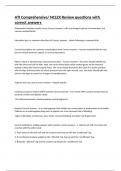ATI Comprehensive/ NCLEX Review questions with correct answers Endometiral infection usually occurs Correct answers - with a prolonged rupture of membranes, not vacuum-assisted births.
Intenstinal gas is a common side effect of Correct answers - clients following a cesarean birth
Cervical lacerations are common complications from Correct answers - vacuum-assisted birth are rare but can include perineal, vaginal, or cervical lacerations
When a client is experiencing a wound evisceration... Correct answers - the nurse should initially stay with the client and call for help. Next, the nurse should place saline-soaked gauze on the exposed bowels to keep the internal organs moist. The nurse should then place the client in a supine position with his hips and knees bent to relieve pressure from the open wound. Last, the nurse should take the client's vital signs to assess for changes in hemodynamics.
Valproic acid can cause Correct answers - hepatic toxicity
continuous passive motion (CPM) machine Correct answers - Turn of the CPM machine during meals to promote comfort and dietary intake.
-The affected extremity should maintain neutral alignment.
Heparin Correct answers - is an anticoagulant that inhibits the conversation of prothrombin to thrombin.
Patients on an anticoagulant drug such as heparin are at an increased risk of bleeding.
-Signs of bleeding: ecchymoses, tarry stools, mucosal bleeding, and pink/ red-tinged urine.
Correct method for walking upstairs with crutches Correct answers - 1. Hold to rail with one hand and crutches with the other hand.
2. Push down on the stair rail and the crutches and step up with the "unaffected" leg.
3. If not allowed to place weight on the "affected" leg, hop up with the "unaffected" leg.
4. Bring the "affected" leg and the crutches up beside the "unaffected" leg. 5.Remember, the "unaffected" leg goes up first and the crutches move with the "affected" leg.
Droplet precautions Correct answers - DROPLET: "SPIDERMAn"
-Sepsis
-Scarlet Fever
-Strep
-Pertussis
-Pneumonia
-Parvovirus
-Influenza
-Diphtheria
-Epiglottitis
-Rubella
-Mumps
-Adenovirus
Management: Private room/mask -A private room a rom with other clients with the same infectious disease.
-Masks for providers and visitors
Airborne precautions: Correct answers - AIRBORNE: "My Chicken Hez TB"
-Measles
-Chicken pox
-Herpes zoster
-TB Management: neg. pressure room, private room, mask, n-95 for TB.
-A private room
-Masks or respiratory protection devices for caregivers and visitors.
-An N95 or high-efficiency particulate air (HEPA) respirator is used if the client is known or suspected to have TB.
-Negative pressure airflow exchange in the room of at least six exchanges per hour.
Contact precautions Correct answers - CONTACT: "MRS WEE"
-MRSA
-RSV
-Skin infections (herpes zoster, cutaneous diphtheria, impetigo, pediculosis, scabies, and staph)
-Wound infections
-Enteric infections (C-Diff)
-Eye infections (conjunctivitis)
Management: gown, gloves, goggles, private room
VRSA - contact and airborne precautions (private room, door closed, negative pressure)
-A private room or a room with other clients with the same infection.
-Gloves and gowns worn by the caregivers and visitors.
Stage I pressure ulcer Correct answers - Intact skin with an area of persistent, nonblanchable redness, typically over a bony prominence, that may feel warmer or cooler than the adjacent tissue. The tissue is swollen and has congestion, with possible discomfort at the site. With darker skin tones, the ulcer may appear blue or purple. Stage II pressure ulcer Correct answers - Partial-thickness skin loss involving the epidermis and the dermis. The ulcer is visible and superficial and may appear as an abrasion, blister, or shallow crater. Edema persists, and the ulcer may become infected, possibly with pain and scant drainage.
Stage III pressure ulcer Correct answers - Full-thickness tissue loss with damage to or necrosis of subcutaneous tissue. The ulcer may extend down to, but not through, underlying fascia. The ulcer appears as a deep crater with or without undermining of adjacent tissue and without exposed muscle or
bone. Drainage and infection are common.
Stage IV pressure ulcer Correct answers - Full-thickness tissue loss with destruction, tissue necrosis, or damage to muscle, bone, or supporting structures. There may be sinus tracts, deep pockets of infection, tunneling, undermining, eschar (black scab-like material), or slough (tan, yellow, or green scab-like material)
Glasgow Coma Score Correct answers - is calculated by using appropriate stimuli (a painful stimulus may be necessary) and then assessing the clients response in three areas.
Eye opening (E) - The best eye response, with responses ranging from 4 to 1 4 = Eye opening occurs spontaneously. 3 = Eye opening occurs secondary to voice. 2 = Eye opening occurs secondary to pain. 1 = Eye opening does not occur. Verbal (V) - The best verbal response, with responses ranging from 5 to 1 5 = Conversation is coherent and oriented. 4 = Conversation is incoherent and disoriented. 3 = Words are spoken, but inappropriately. 2 = Sounds are made, but no words. 1 = Vocalization does not occur. Motor (M) - The best motor response, with responses ranging from 6 to 1 6 = Commands are followed.




